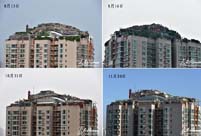China has scheduled to launch its mission to the moon in early December. All tests on the Chang'e-3 moon rover, which has been in Xichang launch center since September the 12th, are going smoothly. Data processing and monitoring work is vital both before and after the launch. CCTV's Hou Na has spoken to a senior engineer at the center to find out more about the preparations.
Another tough day begins.
Che zhuming has been working in Xichang Satellite launch center for more than twenty years. He is in charge of date monitoring and analysis. Having been a part of more than fifty satellite launching missions, he knows how important this one is to send China's first lunar rover to the moon. He calls it groundbreaking.
"This mission has the highest orbital altitude and the heaviest overall weight our launch center has managed, so it requires maximum thrust of the rocket ejector. So the data monitoring work is very challenging." Che said.
Data processing and analysis is vital for the engineers to decide whether the launch process is on the right course, and to make a timely response if any emergency occurs.
Che called himself a huge "data fan". But dealing with huge amounts of data requires more than just interest, but also extreme care and dedication.
"We have installed a camera on the rocket so that we can conduct real-time monitoring of Chang'e 3. The data sent back to the control center is vital for us to evaluate the condition of the satellite." Che said.
The Chang'e-3 moon rover is part of the second stage of China's three-stage lunar probe program, orbiting, landing, and analyzing lunar soil and stone samples.
In addition to several cameras, Chang'e-3 will carry a near-ultraviolet astronomical telescope to observe stars, the galaxy and the universe from the moon.
Reporter: "Compared with the carrier rocket of the Chang'e-2 moon probe, this one has been equipped with a number of new technologies and is even more reliable. The Chang'e-3 moon rover will roam the moon's surface to patrol and explore the Earth's satellite. The data collected by the rover, such as 3D images, infrared spectrums and lunar soil analysis, will directly and accurately lead to greater understanding of the moon."
 Finland has more eggs in the Chinese basket than any other
Finland has more eggs in the Chinese basket than any other In pictures: PLA's digital equipment
In pictures: PLA's digital equipment  Protesters demonstrate during UN Climate Change Conference in Poland
Protesters demonstrate during UN Climate Change Conference in Poland  Self-made farmer billionaire donates 69 villas at hometown
Self-made farmer billionaire donates 69 villas at hometown Demolition of bizarre rooftop villa in Beijing still in progress
Demolition of bizarre rooftop villa in Beijing still in progress Service seminar for E China train attendants
Service seminar for E China train attendants  Supermodel-turned-designer
Supermodel-turned-designer Cheerleaders light up CBA regular season
Cheerleaders light up CBA regular season  Finland--anytime you want is right time to go: Ambassador
Finland--anytime you want is right time to go: Ambassador Maritime counter-terrorism drill
Maritime counter-terrorism drill Splendid views of cities blanketed with fog
Splendid views of cities blanketed with fog  Models dazzle at Int'l Yacht Model Pageant
Models dazzle at Int'l Yacht Model Pageant  How to apply for a green card in China
How to apply for a green card in China Annual Santa Claus parade held in Canada's Montreal
Annual Santa Claus parade held in Canada's Montreal Weekly Sports Photos
Weekly Sports PhotosDay|Week|Month